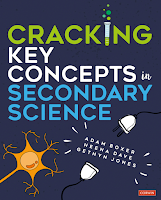This book is very useful - it's full of clear explanations and has saved me a lot of time. I've taken to adding notes in the margin after I use an explanation - was there anything I needed/wanted to add or change, what questions worked particularly well, general tips to get things running smoothly in class, etc etc. It was suggested that I blog the notes so that others could benefit, which is what I'm doing!
I will try to make it as clear as possible what I'm talking about, but I will warn you in advance - if you don't have the book, it's not gonna make sense! I'll update this post periodically as I work my way through the explanations, but I currently don't teach biology or physics to years 10 and 11 so there might be some explanations that never get any notes.
2. Understanding cellular structure and function
- Starting with plant cells was useful because it meant that I could say things like "animals don't do photosynthesis, so they don't need chloroplasts" while not drawing them in
- I started with the plant cell and laid it out as shown in the image. Not quite a table, but I tried to keep things as aligned as I could. Each organelle got its own line [please ignore the repeated switch between plural and singular forms]. What this meant was that I could then scroll sideways and draw the animal cell and keep the same labels, as shown below.
- Something that surprised me was students being baffled that vegetables are [parts of ] plants. "Is a carrot a plant?" "It's part of a plant, yes" 🤯
11. Balancing Equations
- Drill step 1. If they can't do step 1, they can't do anything else.
- When drawing oxygen molecules, if you say "it looks like eyes", it seems to stop them laughing at the fact it looks like boobs. What can I say.
12. The development of the periodic table
- Don't bother with stickers, just use coloured pens. Stickers are slightly too fiddly.
- An index card cut into quarters seems to be a good size to fit under the visualiser, but also be big enough to read clearly.
- I also split the explanation into "stuff about gaps" and "sorting by atomic number vs atomic weight" because I could see they students were beginning to flag.
19. Fractional distillation
- Students answered the question set referred to in Step 6 on MWBs, which allowed me to quickly see how confident they were and if they had suitable prior knowledge without them spending more time than necessary working through things they could do.
- After drawing the column and talking through how the alkanes rise up through it and then condense, I added the extra detail of the trays (the bits inside the column) because some students were confused how the condensed fractions are removed - with the hollow column, some thought the alkanes would "rain" down as they condensed and therefore were unsure how they were removed, whilst others asked if there were fans that "blew" the condensing alkanes out at the right level.
- Added some detail about concept of "fractions", how you're not getting exactly one type of alkane, but instead a selection of alkanes with a particular range of boiling points. Would be tempted to leave this detail out with a lower attaining group.
- Additional questions used:
- Step 3: on MWBs - for each of the following compounds (C4H6, C6H12O6, C90H180, CH4, CH2Cl2, H2O):
- is this a hydrocarbon?"
- "Why [not]?"
- "Is this an alkane?"
- "Why [not]?"
- Step 6: on MWBs - Alkane X has a boiling point of 450°C, Alkane Y has a boiling point of 93°C. Both are heated to 500°C
- Which one(s) will turn into a gas?
- Why?
- They're then cooled. Which will condense first?
- Why?
- At what temperature will Alkane X condense?
- At what temperature will Alkane Y condense?
- I applied the model to an explanation for a y7 distillation lesson which seemed to work well. Started with just the flask, asking students to identify and explain what would happen to each substance at a range of temperatures above and below their boiling points. Then drew in the condenser to finish the explanation.




